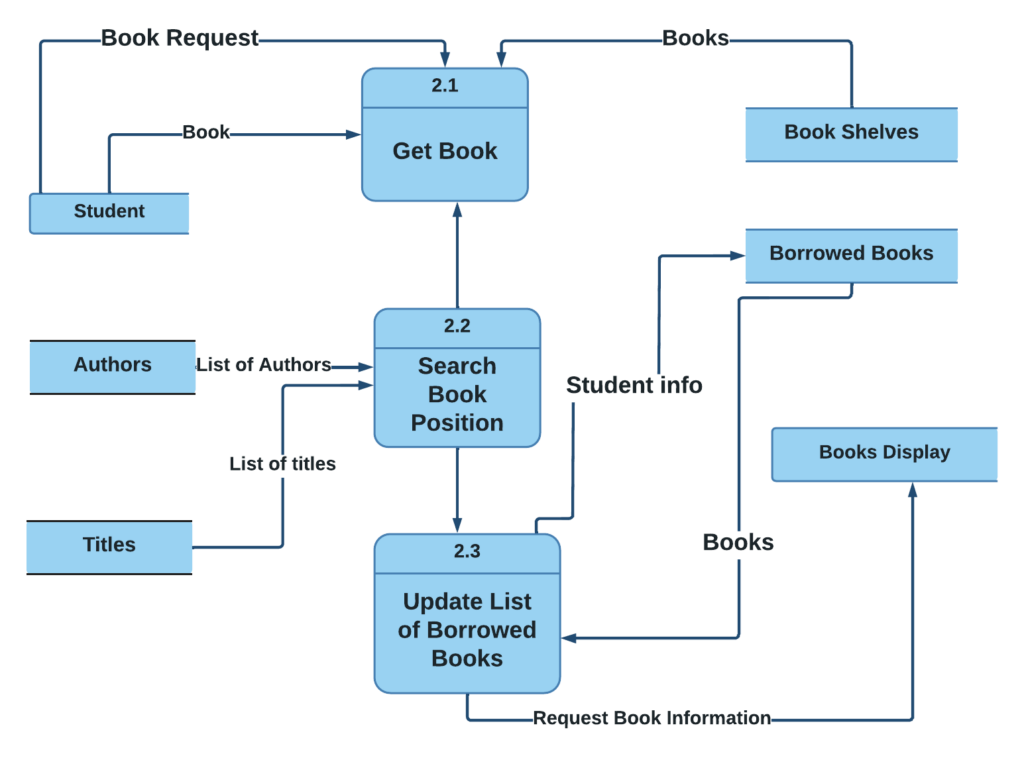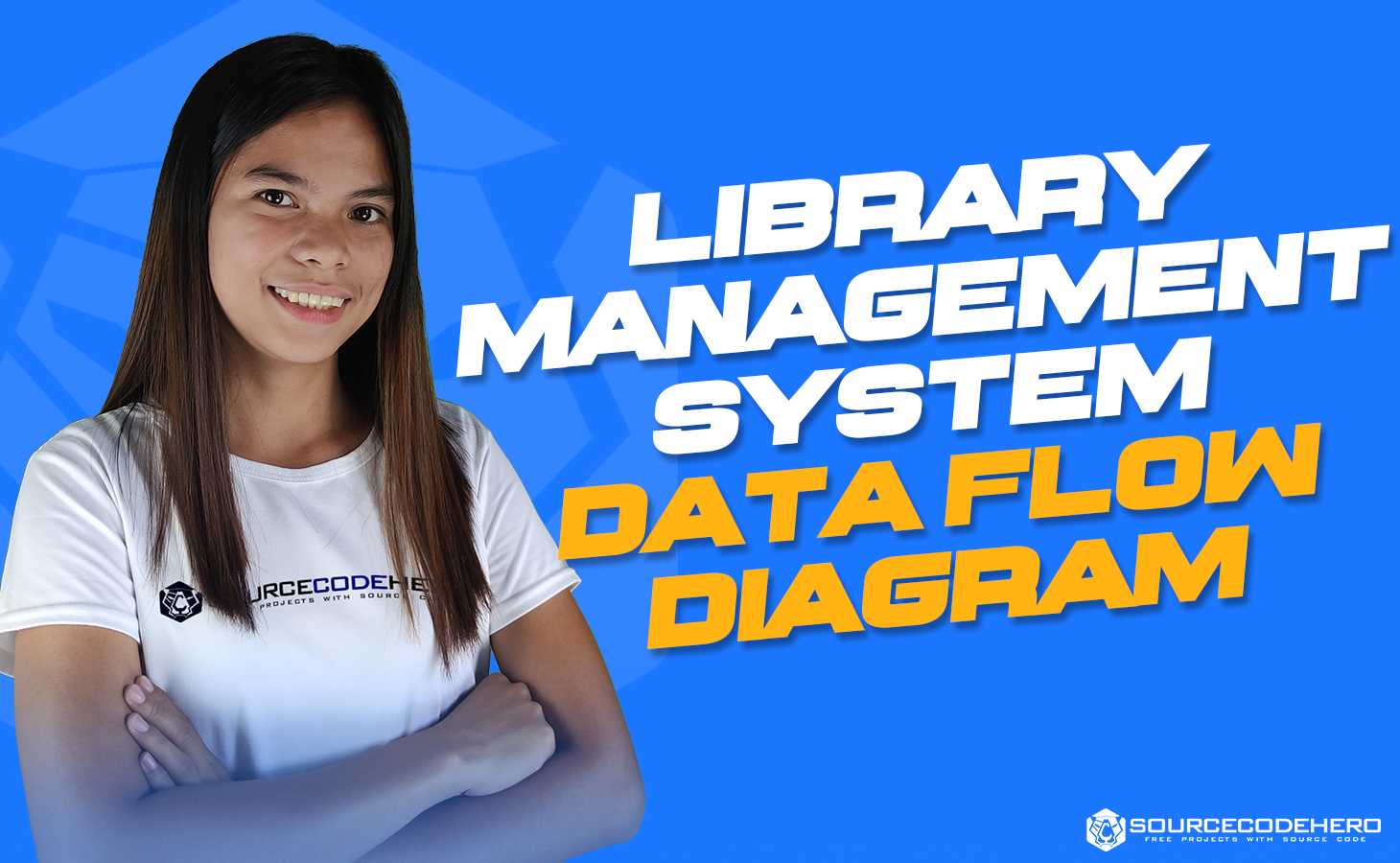The Library Management System DFD shows the “flow” of data in all of the processes that are in Library Management.
This Data Flow Diagram is also referred to as a Data Flow Diagram for Library Management System. It has three levels in its diagram that show how the overall data flow works.
The Library Management System’s Data Flow Diagram or DFD is made up of data, external entities, data storage where information is kept, and processes. It uses symbols to show how the data flows together.
Library Management System Data Flow Diagram: Project Name and Details
The table shows the project name and details of Library Management System Data Flow Diagram. It has complete information about the project’s information.
| Name: | Library Management System DFD (Dataflow Diagram) |
| Abstract: | The Library Management System DFD shows the structure of the project in terms of its data management. It contains the important details on the flow of data and alternatives present in the project. |
| Diagram: | DFD also known as Data Flow Diagram |
| Users: | School Librarian, Student (Book Borrowers), and School Admin |
| Tools Used: | Diagraming tools that provides data flow diagram symbols. |
| Designer: | Sourcecodehero |
What is Data Flow Diagram for Library Management System
The Data Flow Diagram for Library Management System – one of the methods used for library information system development and business process. It represents the system’s major processes and alternatives that generate the flow of data within the system.
Moreover, the data includes in Data Flow Diagram labeled properly to guide the developers on the structure of the Library Management System.
Importance of DFD for Library Management System
The importance of DFD for Library Management System is that it aids the audience in understanding what is happening in the system. This is done by showing them how the system manages its data at different levels of detail.
Example of Library Management System Project Data Flow Diagram
The Library Management System Project Data Flow Diagram is given with explanation. This example Data Flow Diagram are elaborated in three Levels which were the DFD Level 0, 1, and 2.
Level 0 DFD Diagram for Library Management System
The Level 0 DFD Diagram for Library Management System is also known as the context diagram. It is composed of the main process, users and data flows. The concept is shown in a single process visualization.
DFD Level 0 shows the entities that interact with the system. It defines the border between the system and its environment. This context diagram shows Library Management Project at a high level.

The illustration shows the main process in a single node to show where the project is going. Here, we can see how the project will work in a glance. The users put data into the system, and then they get the results from the system after they do that.
You will perceive through the diagram that there is already the presence of data flow. Though the process is very general, the flow of data is clear. This could also be modified to meet the other requirements and could include other matters regarding with Library Management.
DFD Level 1 Diagram for Library Management System
The 1st level DFD Diagram for Library Management System is considered as the detonated view of context diagram. Its function is to deepen the concept derive from the DFD Level 0.
The DFD Level 1 shows the wider details of Library management system DFD Level 0. This is to clarify the paths (flow) of data and its transformation from being an input to an output. The designed DFD level 1diagram portrays two different scenario which is the Book Delivery and the topic search.

The data flow begins with the student providing the borrowing request and his/her information. The system then tailors the data and processes the request. As a result, the process generates data flow and transformation until it achieves the desired output.
You can also see the data store or database that was used. The database used to store the data processed and provided by users, and it also serves as a source of outputs.
You can add more to this, and how you create your data flow diagram is entirely up to you. Only be precise with your information and take into account the data flow need to include.
Library Management System Level 2 DFD
Level 2 DFD for Library Management System is also called the highest abstraction of data flow diagram. This level also broadens the idea from the DFD level 1. It includes the sub-processes from level 1 as well as the data that flows.

This diagram has elaborated the sub-processes derives from “topic search” process. The sub-processes were get book, search book position, and update. These processes were invoked by the book borrower and then catered by the system.
The processes there were all managed by the system without the librarian attending the transaction. But then the librarian can still monitor all the transactions made by the borrower.
Remember that not all of the processes in the project must have sub-processes. Only provide this diagram if needed. It is not required as long as your previous diagrams were clear and precise.
Conclusion:
It is very important for you to know the diagrams that were used to design and build the Library Management System. That is to help you build a fully-functioning system with the help of DFD, so that you can use it. Creating a DFD will help you see the flow of information which needs to process and transform. Not only that, but you can also connect its diagram to other diagrams, too.
Recommended Article from Author:
Inquiries
If you have inquiries or suggestions about Library Management System DFD (Data Flow Diagram), just leave us your comments below. We would be glad to know to concerns and suggestions and be part of your learning.
Keep us updated and Good day!
